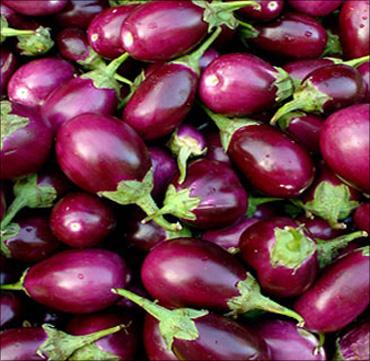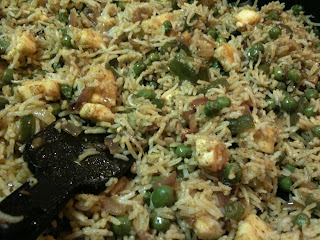Been a while since I jotted down my recipes. I am now gulped into a routine life, but that also means I cook almost everyday. Dear Indians, don't laugh at my comment. It is infact a big deal here to cook! and cooking everyday?? Wooof! If I say that out loud, people around me will give me that "OMG" expression. Hehe! So today you are getting one of my best recipes. Yennegaayi!! I remember when I was 8ish, my cousins and I would go to our village with families for summer holidays. Kids would get dinner served in a very different fashion. One of the mommies would mix food in a huge bowl and we would all have our tiny little hands cupped to receive what I can remember, a dozen servings of yummy food. Typically there would be a nice breeze and someone telling us a story and not to forget a big bright moon or dazzling stars.
Anyway, I have verbally given this recipe to so many people that I was sure it deserves a spot on my blog. Badnekaayi, Brinjal, Baingan, Eggplant whatever you call it, is not the most favorite veggie of many people. Mainly because of its inherent flavor. But you gotto trust me on this recipe that no matter how much you like or dislike brinjal, you will love Yennegaayi!! Hmmm yummmm...
When you look for brinjal/eggplant in store, make sure you find blemish-free tiny round ones as shown below irrespective of the color. You can count 2 for each person or if you are really hungry you could say 3. I would classify making of this dish as "relatively simple" just because of the steps involved in cooking and the actual cooking time would be lesser than making, let's say, bhindi fry(okra fry).

The other ingredients (considering you'll use 10 brinjals) are listed below.
For the masala paste
- 1 onion cut into chunks
- 1 tomato cut into chunks
- 3 tbsp of groundnuts/peanuts
- 10 twigs of coriander leaves
- 1 tbsp coriander seeds
- 1 tbsp sesame seeds (white or black)
- 1 tsp poppy seeds
- 1 tbsp red chilli powder
- 5 pieces of cashews
- 5 tbsp of shredded dry coconut (in case you don't have shredded, you could use fresh or frozen grated coconut)
- 1 twig curry leaves
- 1 inch of ginger coarsely chopped
- 1 tbsp jeera/cumin seeds
- 1 tbsp mustard seeds
- 1 piece of cinnamon
- 1 small cube jaggery
- 1 tbsp tamarind paste
- Salt to taste
Now don't freak out with the number of ingredients. They'll all go into the blender soon! ;-)
Heat 2 tbsp of oil in a pan and add mustard seeds, jeera/cumin seeds, cinnamon, groundnuts/peanuts, coriander seeds, sesame seeds, poppy seeds, ginger, curry leaves, shredded coconut in the same order preferably. If you are using grated coconut, do not bother adding it to the pan. Roast it all by mixing nicely till groundnuts/peanuts turn slightly golden brown. Let the mixture cool and add it in a blender along with coriander leaves, cashews, onion, tomato and grated coconut if applicable. Grind the mixture into a fine thick paste by adding adequate amount of water. Pour this paste back to the pan and add salt, jaggery, tamarind and red chilli powder and let it cook till the blended paste turns slightly darker.
Heat 2 tbsp of oil in a pan and add mustard seeds, jeera/cumin seeds, cinnamon, groundnuts/peanuts, coriander seeds, sesame seeds, poppy seeds, ginger, curry leaves, shredded coconut in the same order preferably. If you are using grated coconut, do not bother adding it to the pan. Roast it all by mixing nicely till groundnuts/peanuts turn slightly golden brown. Let the mixture cool and add it in a blender along with coriander leaves, cashews, onion, tomato and grated coconut if applicable. Grind the mixture into a fine thick paste by adding adequate amount of water. Pour this paste back to the pan and add salt, jaggery, tamarind and red chilli powder and let it cook till the blended paste turns slightly darker.
It is a good idea to pre-cook the brinjals halfway beforehand while preparing the masala paste since it saves a lot of cooking time. I'd say microwave it fully immersed in water for 3 mins or you could do the same on stove top. However, pay attention to the way brinjals are cut. You gotto retain the green stem without chopping it off and cut the brinjal from the bottom in quarters, not going all the way to the stem.
Now there are two methods of cooking, one in a pressure cooker and another in a sauce pan with lid. If you prefer to cook in a pressure cooker, one whistle would suffice, but keep the lid closed for 20 mins after you turn off the heat.
The next stage is to get the masala paste and brinjals together. Here is what you do.
- Finely chop one onion and fry it in 6 tbsp oil. To this add turmeric, asafoetida and let it fry till onions turn golden brown.
- In parallel, carefully stuff the brinjals/eggplants with masala paste without breaking it apart.
- Add these stuffed brinjals to the saucepan when the onions are ready.
- Pour the remaining masala paste on top of these brinjals.
- Close the lid and let it cook for 20 mins, during which occasionally turn the brinjals around to ensure it cooks well all around. Do not let the brinjal shrink a lot. That would mean overcooking!
- When done, you could garnish it with a bit of chopped coriander leaves.
Or when done, I wouldn't wait to serve it on a plate with chapathis or rotis or bread or even with rice and start relishing it.




